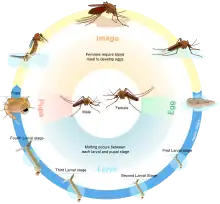| Aedes infirmatus | |
|---|---|
 | |
| Scientific classification | |
| Domain: | Eukaryota |
| Kingdom: | Animalia |
| Phylum: | Arthropoda |
| Class: | Insecta |
| Order: | Diptera |
| Family: | Culicidae |
| Genus: | Aedes |
| Species: | A. infirmatus |
| Binomial name | |
| Aedes infirmatus | |
Aedes infirmatus, informally referred to as the infirm American pointy mosquito or silverback mosquito, is a species of mosquito that is found in woodland environments in parts of Central America, Mexico, and the southern United States, with a type locality in Baton Rouge, Louisiana.[1] In the United States, they have been found as far west as Texas and as far north as New Jersey.[2]
Description
Adults of the species have a dark-scaled proboscis, dark legs, and a broad silvery white patch on their thorax which helps distinguish them from other species of similar appearance.[1]
Life cycle

Females of this species typically lay their eggs in low-lying grassy areas prone to flooding; the eggs are stimulated to hatch by flooding which often takes place in the spring. Adults will opportunistically feed on passing hosts, including humans, in the woodland environments where their populations are most dense, but only rarely enter buildings.[1][3] Studies in northeastern Florida found a negative correlation between population density of A. infirmatus and agricultural land use, and additionally found that average peak abundance for the species typically occurred between June and August.[4]
Medical importance
This species of mosquito vectors a variety of pathogens, including California encephalitis virus, Keystone virus, trivittatus virus, West Nile virus, and Eastern equine encephalitis.[1]
References
- 1 2 3 4 "Aedes infirmatus Dyar & Knab, 1906 | Walter Reed Biosystematics Unit (WRBU)". www.wrbu.si.edu. Retrieved 2023-06-23.
- ↑ McNelly, J. R. (June 1989). "Occurrence of Aedes infirmatus in New Jersey". Journal of the American Mosquito Control Association. 5 (2): 277. ISSN 8756-971X. PMID 2746215.
- ↑ "Aedes infirmatus, Aedes tormentor". www.coj.net. Retrieved 2023-06-23.
- ↑ Steck, Madeline; et al. (2021-06-10). "Relationship of precipitation and habitat to the spatial and temporal abundance of Aedes atlanticis and Aedes infirmatus in St. Johns County, Florida". Journal of the Florida Mosquito Control Association. 68 (1): 24–37. doi:10.32473/jfmca.v68i1.129095. ISSN 2638-6054. S2CID 236305713.